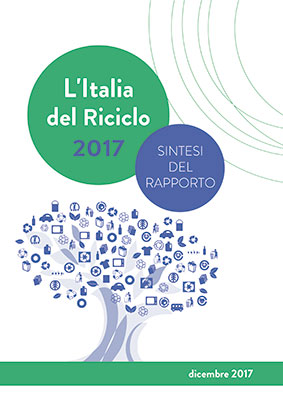Waste recycling: Italy beats European average
In December, the eighth edition of a report on waste recycling in Italy was presented, authored by the Sustainable Development Foundation and FISE UNIRE, with support of the Ministry for the Environment and ISPRA. Below is a summary of the main findings on packaging collection and recycling.
 Italy, and Europe generally, is on the precipice of an ambitious relaunch of waste management policies, toward greater resource circularity. The new, ambitious targets set by the Circular Economy Package and the simultaneous adoption of uniform criteria for calculating recycling performance are sure to have a strong impact on the market, but also on the national resource management system. Another promising positive effect of these policies will be that they will help stabilize demand for and prices of recycled materials, providing greater certainty for investors.
Italy, and Europe generally, is on the precipice of an ambitious relaunch of waste management policies, toward greater resource circularity. The new, ambitious targets set by the Circular Economy Package and the simultaneous adoption of uniform criteria for calculating recycling performance are sure to have a strong impact on the market, but also on the national resource management system. Another promising positive effect of these policies will be that they will help stabilize demand for and prices of recycled materials, providing greater certainty for investors.
Focus on packaging: excellence in management
Italy’s recycling industry, consolidating its growth, recycled 67% of packaging in 2016 and processed growing volumes of waste recovered from separate collection (organic and textiles) and from electronics (AEE).
The waste management business is worth over 23 billion euros and employs 133,000 people. 20 years since the first comprehensive legislation was passed enabling the formation, evolution and growth of a sector that over time has become an industry, Italy has achieved excellence in waste recycling.
These are the main findings shared during the annual report’s presentation.
In the various national supply chains, recycling has maintained high levels in 2016, reaching a share of 8.4 million t recycled (3% more than in 2015), or 67% of total output for consumption.
The most significant growth has been in aluminium (+5%), steel (+4%) and wood (+4%), while excellent performance has continued in paper (80%) and steel (77.5%). In 2016, organic waste, which has always represented the main component of recovered urban waste, has gradually increased its share of total separately collected waste, rising from 40% in 2011 to 41.2% in 2016, or 107.6 kg per resident.
The values of an industrial system
The report’s 2017 edition, in addition to delving into the dynamics of various industries, offers a focus (authored by Ecocerved) on the evolution of waste management in Europe, and in Italy in particular, during the 20 years since the passage of Legislative Decree 22/97.
In 2014, 51% of total waste processed in Europe was recovered, while 49% was sent to a landfill. In Italy and Germany, the rate of recovery is significantly higher than the European average, reaching as high has 79%; in France it reaches as high as 69%.
In the EU, the waste management sector generates a total turnover of 155 billion euro and produces almost 50 billion euro in added value; both figures show nominal growth of some 10% over 2011.
It is also in economic terms that Germany is the top performer, while Spain has seen the greatest acceleration during this period (+25% in turnover and +50% in added value since 2011). Italy, with over 23 billion euro, accounts for 15% of Europe’s total waste management turnover in 2014.
Landfills’ shrinking share. Nationally, the amount of waste recovered more than doubled between 1999 and 2015, from 29 to 64 million t, while the amount sent to landfills was drastically cut from 35 to 18 million t. In 2015, 55% of waste managed was recovered, while 16% was dumped and 29% was destined for pre-processing, compared to 38%, 46% and 17% in 1999, respectively. A remarkable trend inversion has also occurred between urban waste and separate collection, with recovery outpacing trashcans.
Growing business with decreasing involvement of microbusinesses. At the same time, the profile of businesses in this field has changed: some 10,500 concerns managing waste in 2015, as either their main business or as a secondary component, represent a reduction in their ranks in 1999, following many mergers, with a significant increase in the presence of publicly traded companies, and a constant reduction of individual concerns, which have been halved during this period, a sign of the sector’s progressive industrialization.

















